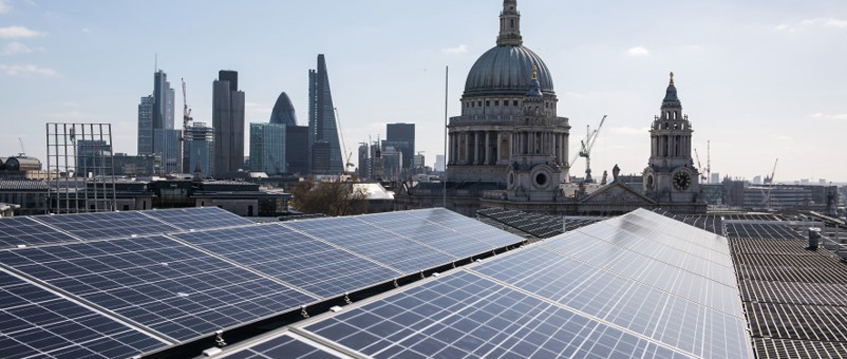COMMENT: Sustainability is rising up the agenda as investors put emphasis on corporate responsibility and growth.
The property industry is now at the heart of the UK’s drive to reach the 2050 net zero carbon goal; some of this action has come from the government’s commitment and some has come from within, as the industry recognises the imperative to act now. Momentum has been building at speed over the past 12 months and it is positive to see increasing business leadership and collective action on a number of sustainability issues.
With notable figures such as Mark Carney and Larry Fink expressing the risk to future investments, there is no doubt that we are at a pivotal moment of defining sustainable investment strategies – something that was also evident within JLL’s 2020 investor survey. In January 2019, just 7% of respondents selected environmental changes as a top-three long-term trend impacting real estate, the lowest of any option. Fast-forward 12 months and more than two-thirds selected sustainability and climate change – comfortably the number-one choice. The survey also identified that the key motivations for investing in a more sustainable way were corporate responsibility and growth in long-term returns.
BREEAM impact on office performance
Hard evidence of increased value and performance associated with sustainable buildings can however be difficult to obtain. At present, environmental ratings and other certification schemes are entered into voluntarily, but they also serve as a good benchmark to understand impact on office performance.
The latest research from JLL sought to add to this conversation by demonstrating the increased financial benefits that sustainable buildings can deliver to investors, through a combination of higher rents and stronger leasing velocity. This first-of-its-kind research involved the analysis of 1,500 leasing transactions of 370 grade-A office buildings in central London, finding that those with a BREEAM rating of “very good” or above achieved higher rents than those without a rating. It was also found that the average rental premium for non-rated buildings over the last three years was around 8%.
The research further demonstrated that investors who target higher BREEAM ratings are rewarded with higher occupancy rates throughout the cycle. JLL analysed the leasing velocity of 200 central London schemes and found that those that are rated “outstanding” or “excellent” tended to demonstrate higher pace of leasing and lower void rates – of 14% compared with 38% for those rated “very good” – 12 months after completion.
Moreover, the research showed that the relatively few BREEAM “outstanding” offices in central London are more likely to be prelet than buildings with lower ratings and have all been almost fully let on completion. In most cases, the “outstanding”-rated buildings are located away from the City core – for example in Shoreditch, Pancras Square, King’s Cross and Stratford.
Occupiers are responding
Performance ratings however are only one side of the equation. Pressure on the real estate industry to act is also being driven by action from organisations on their own sustainability journeys. There has been notable acceleration in the number of leading organisations publicly stating their sustainability targets and, while most have signed up to science-based targets (SBTs), others have gone further in declaring net zero carbon targets or beyond. For example, Microsoft, which recently declared ambitious plans to be carbon negative by 2030, has also pledged that by 2050 it will have removed all the carbon it has emitted since it was founded in 1975. Not an easy task.
The latest data shows that globally more than 800 companies have signed up to the SBTs in line with the Paris Agreement to limit global warming to 1.5°C. However, just 45, including JLL UK, have declared an ambition to be net zero carbon via the World Green Building Council. As companies come under scrutiny from their employees, customers, shareholders and the population at large, participation in these commitments provides a positive message around a firm’s corporate governance and social responsibility, so we can only expect numbers to increase.
With JLL’s occupier research showing that, for knowledge management firms, as much as 90% of emissions come from buildings and travel, we will undoubtedly also see increased demand for sustainable buildings, as organisations realise the part that selection, occupation and operation of buildings will play in achieving their goals. JLL has calculated that organisations committed to SBTs occupy approximately 12m sq ft, of which around two-thirds have a lease expiry before 2030, and we fully expect more environmental commitments to be announced.
Towards a collaborative partnership
With more occupiers committing to environmental targets, the pressure to engage with the supply chain to reduce direct emissions will intensify, and this will mean increased pressure on real estate and landlords too. A move to occupy environmentally efficient or even net zero carbon buildings can help support this message to company stakeholders and employees.
However, to be successful, there has to be greater collaboration and partnership throughout the lifecycle of the building. Landlords need to be explicit with occupiers as to how the building is designed to be operated and reassess performance regularly, while occupiers need to understand their role in operating the office space in an energy-efficient and sustainable way.
The time is now
Clearly the urgency to build more sustainable buildings in central London is only accelerating, and the first developers to undertake the task will reap the rewards of high levels of demand and the intrinsic higher performance. Yet, this opportunity to provide sustainability as a point of differentiation, to appeal to forward-thinking occupiers, is subject to some time constraints as tougher building regulations, which will drive a reduction in energy consumption and carbon emissions, are more than likely to come to the fore. As mandated sustainability performance becomes more defined, and the link to value becomes clearer, the premium associated with it will disappear and buildings that don’t comply will underperform.
Neil Prime is head of central London markets and UK agency and Elaine Rossall is head of UK offices research at JLL








